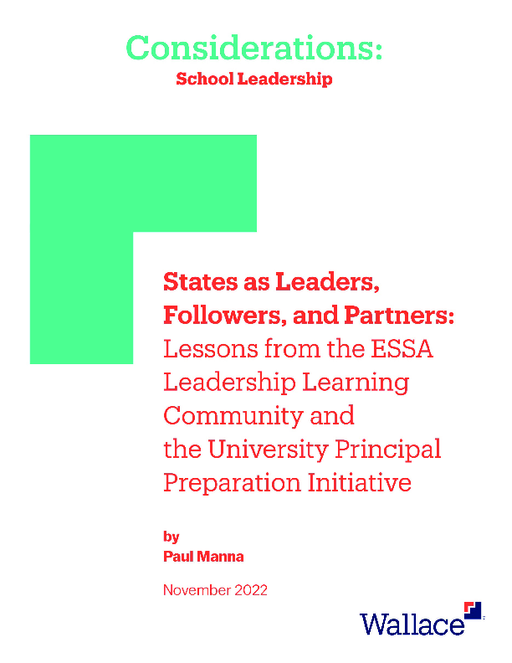
Breadcrumb
- Wallace
- Reports
- States As Leaders, Followers, An...
States as Leaders, Followers, and Partners
Lessons from the ESSA Leadership Learning Community and the University Principal Preparation Initiative

- Author(s)
- Paul Manna
- Publisher(s)
- The Wallace Foundation
Summary
How we did this
The paper considers research that examined the ESSA Leadership Learning Community and the University Principal Pipeline Initiative along with the broader literature on state policy and principals that informed both. The paper’s analysis discerns key implications of each effort and broader lessons for state and local policymakers and others.
Two different efforts by The Wallace Foundation in recent years sought to encourage states to take a more active role in shaping high-quality school principals. This report by political scientist Paul Manna draws conclusions from those two efforts. In particular, he examines the evidence for how states can contribute to better instructional leadership.
The two initiatives Manna examined were:
The ESSA Leadership Learning Community (2016-2021). This initiative launched in response to a federal law providing states with significant authority over federal education funds. The learning community brought together teams from 11 states. The teams comprised local districts in the state, community groups, state agencies and others. Teams worked to promote effective school leadership in their localities.
The University Principal Preparation Initiative (2016-2022). Seven university principal preparation programs in seven states worked to improve their programs. They did so in partnership with nearby school districts and state agencies.
How States Influence Principal Quality
Manna identities a number of common themes in the two initiatives.
One is that states can help link school districts with other organizations to solve common problems in education. These organizations may include community groups, state agencies, and professional associations. Such partnerships can provide school districts with fresh ideas and resources. This increases the likelihood that principal quality initiatives will succeed. Networks need to be established with a clear process for building trust and agreeing on goals.
Another is that state standards for the principal’s job can be a powerful policy lever if used well. Standards used well can influence principal training, development, and support. Standards used poorly can foster compliance work and fail to improve principal quality.
Yet another theme is that state policies can positively influence or unintentionally undermine efforts to improve school leader quality. For example, weak standards for approving principal preparation programs can result in underprepared school leaders. Raising standards can improve preparation.
Choosing a Model
The two initiatives varied considerably in both aim and approach. Manna offers a number of considerations for state officials when choosing one of these models. Among them:
- The University Principal Preparation Initiative model might be the right option for improving specific problems located within an institution.
- The ESSA Leadership Learning Community might be the right option for better defining a problem and considering a range of possible policy solutions.
Manna concludes that the success of both models clearly shows that state policymakers have an invaluable role to play in advancing the principalship. State officials need not stand on the sidelines when it comes to improving principal quality.
This report is part of an occasional Wallace series titled Considerations. In the series, experts share insights based on research and theory on important issues in the areas where Wallace works.

Addressing the challenges confronting principals requires much more than school district human resources offices or professional development units performing well. States are crucial partners.
Related Reports
- Using State-level Policy Levels to Promote Principal Quality
- All the Voices: Statewide Collaborations for School Leadership under ESSA
- Developing Excellent School Principals to Advance Teaching and Learning: Considerations for State Policy
- How Can State Policy Support Local School Districts as They Develop Principal Pipelines?
Key Takeaways
- Two different efforts by The Wallace Foundation in recent years encouraged states to take a more active role in improving principal quality. This report draws conclusions from those two efforts. In particular, it examines how states can contribute to better instructional leadership.
- One theme is that states can help link school districts with other organizations to solve common problems in education. These organizations may include community groups, state agencies, and professional associations. Such partnerships can provide school districts with fresh ideas and resources. Networks need to be organized with a process for establishing trust and agreeing on goals.
- Another theme is that state standards for the principal’s job can be a powerful policy lever if used well. Standards used well can influence principal training, development, and support. Standards used poorly can foster compliance work and fail to improve principal quality.
- States should consider drawing on these two models for improving principal quality depending on their needs.

